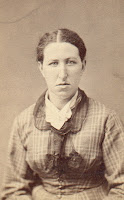 |
| Harrigan homestead Kinkora, Ontario |
David Daniel Harrigan (1792-1875) and Christianna O’Hearn
(1787-1850)
David Daniel Harrigan & Christianna O’Hearn
Daniel David
Harrigan & Mary Dolan
David Paul Harrigan & Catherine Mary Harrigan
Daniel Peter Harrigan & Florence Mary Dowd
Dorothy Madeleine Harrigan &
Russell Mackie Bragg
Me
 |
| Graves of David and Christiana St. John the Evangelist Caledon, Ontario |
David and Christianna were both from County Cork Ireland and
that is where they married. Their four
eldest children, Daniel, David, Eleanor and Catherine were all Irish born. In 1832 David and his brothers Dennis and
Jeremiah travelled with their families to Canada. Jeremiah died on the voyage, leaving his
young widow, Jane Mahoney and their infant daughter, Susan on their own. Dennis settled in New Brunswick and was the 4th
great grandfather of Bing Crosby.
David
carried on down the Saint Lawrence by cattle boat and created a farm at Caledon
in Peel County. They had four more
children, William, Edward, John and Francis.
After Christianna’s death in 1850, David married Jane Mahoney Harrigan,
widow of his brother Jeremiah. Both
David and Christianna are buried at St. John the Evangilist Catholic Cemetery
in Caledon.
Martin Dowd (1815-1905) and Brigit Duffy (1811-1897)
Martin Dowd & Brigit Duffy
John Joseph Dowd & Mary
Florence McCarthy
Florence Mary Dowd & Daniel Peter Harrigan
Dorothy Madeleine Harrigan & Russell Mackie Bragg
Me
Martin Dowd and his bride, Brigit were born in Kilglass,
County Sligo, Ireland and emigrated from Ireland to Peel, Ontario as part of
the great famine migration of 1847.
Eventually they settled in Wentworth, where Martin opened a butcher
shop. The pair raised seven children,
Helen, Catherine, Mary Ann, John Joseph, Thomas, Margaret and James. Bridgit died on May 25, 1897 in Wentworth and
Martin followed her in April of 1905.
Both are buried at St. John the Evangelist Catholic Cemetery in
Caledon.
Hugh Kennedy(1817-1864) and Mary Kennedy (1825-1897)
Hugh Kennedy & Mary Kennedy
Catherine Mary Kennedy &
David Paul Harrigan
Daniel Peter Harrigan & Florence Mary Dowd
Dorothy
Madeleine Harrigan & Russell Mackie Bragg
Me
 |
| Grave of Hugh and Mary Kennedy St. Patrick's Cemetery Kinkora, Ontario |
Hugh Kennedy was another ancestor who came to Canada to
escape the great famine. Along the way,
he met, courted and married a distant cousin, Mary Kennedy in Toronto. The pair settled in Kinkora, Ontario and were
neighbours of the Harrigans there. They
raised a family of three girls, Catherine Mary, Julia and Elizabeth; and three
boys, Daniel, Cornelius and Dennis. Hugh
died in 1864 and is buried at St. Patrick’s Church, Kinkora and Mary followed
him in 1897. Their eldest daughter
married David Paul Harrigan.
Thomas Dolan (1783-1871) and Mary Quinn (1807-1857)
Thomas Dolan & Mary Quinn
Mary Dolan & Daniel David
Harrigan
David Paul Harrigan & Catherine Mary Kennedy
Daniel Peter Harrigan
& Florence Mary Dowd
Dorothy Madeleine Harrigan & Russell Mackie Bragg
Me
 |
| Mary Dolan Harrigan |
Thomas Dolan and Mary Quinn are quite a mystery. We know of them only by examining the records
of Mary Dolan, their daughter. Mary was
born in Ireland and so we are not even sure that Thomas and Mary ever set foot in
Canada. Mary Dolan married Daniel David
Harrigan in 1840 in Caledon, Ontario. In
about 1850, the family moved to Kinkora and began farming there.



















